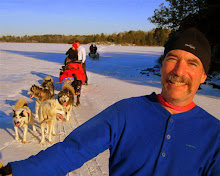The title "Fields Of November" is taken from a Norman Blake song and album of that title. My old FM disc jockey and music aficionado friend Michael Curtis sent me the album on cassette tape when I was living at Anaktuvuk Pass in 1976. Michael could never have realized how much those carefully boxed up tapes meant to me during the long and cold winters there in that high arctic mountain pass, where the sun went down, not to return for months. I would come back from teaching the Nunamiut students, feed my dogs by headlamp light and then go into my little cabin and cook dinner while listening to the tunes from another world.
I remember going for a walk,as Principal of the new school on St. Lawrence Island, looking at the lowland tundra with a wind blown striation of snow crust with Blake's song going around in my head. That tundra landscape would begin to look like a Midwestern landscape, especially if I scrunched up my eyes as I walked. Music can be magic!
Lynn and our eldest son's dog, Dixie in our upper field, out for a walk to try some of the late apples still on trees in the hedge rows and woods. This was a superlative year for apples at our place, in spite of the drought. Apples this year were extra sweet and made cider so sweet that we would dilute it with water.
I remember going for a walk,as Principal of the new school on St. Lawrence Island, looking at the lowland tundra with a wind blown striation of snow crust with Blake's song going around in my head. That tundra landscape would begin to look like a Midwestern landscape, especially if I scrunched up my eyes as I walked. Music can be magic!
Lynn and our eldest son's dog, Dixie in our upper field, out for a walk to try some of the late apples still on trees in the hedge rows and woods. This was a superlative year for apples at our place, in spite of the drought. Apples this year were extra sweet and made cider so sweet that we would dilute it with water.

The vegetable garden on the field near our house has been through many transitions over the years. One of the first garden acts that Lynn tried was the Ruth Stout Method to prepare the spot for a garden. In this method Lynn, with help from the whole family, lay down newspapers over the thick field grass, after first cutting the grass to stubble. Over the newspaper she lay grass and many broken bales of hay and straw. The layers were all wet down and then we took off for Alaska for the winter. When we returned in the spring the garden plot layers were composted down and filled with earth worms. The thick turf was composted down and easily worked and ready to plant without having to spade up the whole area in preparation for planting. I was amazed upon looking at the newspaper and straw mulch in the spring to see how the earth worms, moisture and warm soil had composted down to soil over the winter. I have since learned that the deep snow pack insulates the ground so that it hardly freezes where it is not disturbed so it is actively decomposing through most of the winter.
Having a garden in south central and then the interior of Alaska had made Lynn prefer raised beds for gardening. The raised beds had helped to get the seed beds up off the cold soil for better growing conditions. Lynn has continued down here to prefer raised beds, though permafrost is non-existent. Lynn mulches the walkways between the raised beds to control weeds and heavy mulch around all the plantings keeps down grass and weeds as well as retains moisture.
The deer, hare and other animals made gardening a bit of an extra challenge but the electric fence that we put up this year made it easier to not end up with the garden nibbled down by deer at night. The little solar powered box and battery seemed to keep them out for once!
Muir and his girlfriend Katelyn want to help plant an expansion on the garden so the area of the picture outside the fence is the expansion. It should be all ready by the spring time.
Our wood yard, where a lot of my time is put in during autumn. I am working on next winter's heating wood with a lot of help from Muir. The jumble of wood in the foreground is yellow birch and maple that Muir has taken while out grouse hunting with his friend Kyle. He cuts it off of logging sites, loads it in his truck and brings it home where I wheel barrow and dump it, making a long continuous pile that is then split with wedges, sledge hammer and maul; stacked and covered with long and narrow tarps. As Thoreau said,"Wood warms you twice, once when you cut it and a second time when you burn it." I would say that there is a lot more warming than twice with all the cutting, moving, splitting and stacking.




No comments:
Post a Comment